Geotimes

Untitled Document

Geomedia
Geotimes.org offers
each month's book reviews, list of new books, book ordering information and new
maps.
Check out this month's On
the Web links, your connection to earth science friendly Web sites. The
popular Geomedia feature is now available by
topic.
Books:
Seeing landscapes from above
This is not your father’s creationism: A review
of Creationism’s Trojan Horse
DVDs:
Hubble’s anniversary
On the Shelf:
Mars and beyond
Seeing
landscapes from above
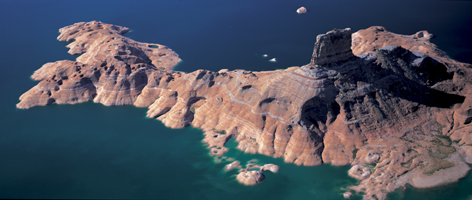 One
geologist who has brought his own photos to laypeople is Ken Hamblin, a professor
emeritus at Brigham Young University (BYU) in Provo, Utah. He was inspired to
put together his book, Beyond the Visible Landscape: Aerial Panoramas of
Utah’s Geology, after looking at the shelves of aerial shots of national
parks such as the Grand Canyon, Zion and Bryce. Hamblin says that often “what
you see is discouraging for the geologist, in a way. Aesthetically, it’s
beautiful,” he says of the books, but “scientifically it’s useless”
because professional photographers tend not to frame images for the geology.
One
geologist who has brought his own photos to laypeople is Ken Hamblin, a professor
emeritus at Brigham Young University (BYU) in Provo, Utah. He was inspired to
put together his book, Beyond the Visible Landscape: Aerial Panoramas of
Utah’s Geology, after looking at the shelves of aerial shots of national
parks such as the Grand Canyon, Zion and Bryce. Hamblin says that often “what
you see is discouraging for the geologist, in a way. Aesthetically, it’s
beautiful,” he says of the books, but “scientifically it’s useless”
because professional photographers tend not to frame images for the geology.
Cookie Jar Butte on Lake Powell in Arizona contains a series of remarkable “holes”
formed in the Entrada Sandstone, and captured aerially for the recent book Beyond
the Visible Landscape. Courtesy of Ken Hamblin.
“The geologist will photograph what he sees: all these exciting things
that the landscape has to tell us. To most people, it’s invisible,”
Hamblin says, “because they don’t have the background to see it.”
Using a panoramic camera “to provide a new perspective of the landscape”
only now made possible with technological advances and Cessna planes, Hamblin’s
40 years’ worth of geologic field experience is included in the explanation
of every image in his book. The geologic descriptions for each image are easily
accessible to lay readers, from the “graceful sets of cross-bedding”
exposed at Checkerboard Mesa in Zion National Park, to a panoramic view of the
Canyonlands “that no one has ever seen before,” Hamblin says, to the
Grand Staircase in panorama and photographs of each “step,” each accompanied
by explanatory cross sections.
Over the 15 years he has been photographing Utah from the air, noticeable changes
in the landscape “have been initiated by humans,” Hamblin says. Lake
Bonneville’s gravel shorelines, for example, he says, are now in nearby
freeways.
The variety of geologic changes Hamblin has documented include the effects of
flash flooding in both wild and urban settings. “What we’ve been teaching
the students is true: Earth is a very dynamic thing. Any one moment may look
stable,” he says of the photos, “but it is in constant flux.”
In 1983, flooding created 91 landslides in the Wasatch Mountains, ripping up
homes and leaving scars on slopes, some of which are now populated again.
Hamblin says his “purpose is to show the remarkable landscape of Utah from
above,” but the book also serves a slightly different objective. When publishing
companies could not bring the costs of publication down so that the book’s
price would be affordable, Hamblin says, the BYU geology department published
it, and all proceeds are folded back into travel funds for BYU students, who
go into the field in Hawaii, Alaska and elsewhere.
Although professional photographer Alex MacLean is not a geologist, his images
in Designs on the Land: Exploring America from the Air vividly portray
how people have used and changed the landscape — from an open-pit mine
that looks like a big carved bowl in the earth, to green crop circles in the
desert and orderly rows in a tree farm, to rectangular factory skylines and
loops of suburban streets. An architect by training, MacLean’s aim seems
to be more environmental than geological, to record development and human impacts
on a landscape, according to his Web site.
MacLean’s geologic images portray a larger scale of geologic processes,
in time if not in space. One image shows knife-sharp ridges that radiate from
a needle-like tower in the West’s Basin and Range. River deltas and tiny
canyons carved by streams in the western Midwest to the Grand Canyon also portray
geologic phenomena from above.
Professional photographer and geologist Michael Collier also has studied landscape
changes from the air, from a geologic perspective, covering Alaskan glaciers
to the San Andreas Fault (see Geotimes, May 2005).
While in his 20s, Collier says that he decided to study “something that
would inform photography,” and he settled on geology because of his love
of landscapes. As a structural geologist, among his other professions, Collier
has created books that show — using aerial photos — as well as tell
about everything from glaciers to the Grand Canyon. “My intention was all
along [to] present geology to laypeople,” he says.
Although the ultimate geologic view from a plane may be astronauts’ photographs,
snapped from the space shuttle, a more accessible space view can be found flying
at 35,000 feet. A travel companion called Window Seat: Reading the Landscape
From the Air, by Gregory Dicum, provides images and geologic details for
a lay person or geologist traveling on major airline routes in the United States,
from the glacial outwash of the Corn Belt to the barrier islands of the Outer
Banks and the volcanoes of the West.
Window Seat and these other photo books make it unnecessary to hire a Cessna
or learn how to focus a camera to indulge in such aerial views. “The tiny
details fall away,” such as rocks, trees and streets, Dicum writes. “From
outside the ordinary human scale, we can see things normally not visible to
us.”
Naomi Lubick
Images from these volumes and more can be seen
online. See below for links to these photographers’ work and sources for
aerial landscape views.
Links:
Book
Cliffs and Bryce
Canyon, pages of Kenneth Hamblin's Beyond the Visible Landscape: Aerial
Panoramas of Utah’s Geology
Alex MacLean's Web site Landslides
"Michael Collier: Doctor,
Photographer, Geologist," Geotimes, May 2005
Window
Seat publisher's Web site
LPI Space
Shuttle views of Earth
Back to top
Book review
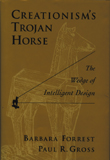 Creationism’s
Trojan Horse: Creationism’s
Trojan Horse:
The Wedge of Intelligent Design
by Barbara Forrest and Paul R. Gross.
Oxford University Press, 2004.
ISBN: 0 1951 5742 7.
Hardcover, $40.00 |
This Is Not Your Father’s
Creationism
Mark A. Wilson
Earth scientists will soon be wishing for the old days when creationists held
such distinctive positions as believing Earth is only a few thousand years old,
a worldwide flood produced all sedimentary rocks, and that people and dinosaurs
knew each other. Many dramatic battles were fought against this pseudoscience,
and we learned much about the politics of science, education and religion in
a constitutional democracy, but we did not have to do much deep thinking. “Young
Earth Creationism,” as we now call it, is so fractured with contradictions,
misconceptions and delusions that it sometimes seems a self-parody. We learned
how to defend science against such nonsense in the courts and public schools,
and we won every case.
These legal and political victories against creationism, though, may have misled
us. Despite all the resources devoted to public education, nearly half of all
Americans still believe evolution never happened. The political energy in this
population, along with new leadership tested in the conflict, has produced a
reformed creationism far more sophisticated than the old.
Under the euphemism “intelligent design” (ID), creationism is once
again rattling state legislatures and alarming those who care about the integrity
of science education. Creationism’s Trojan Horse is a thorough documentation
of the political rise and strategic goals of the ID movement. It is critical
intelligence we need now.
“The wedge” is the name that proponents of ID gave to the movement,
which started in 1992 under the leadership of Phillip E. Johnson, a law professor
who had recently written a book called Darwin on Trial. As philosopher
Barbara Forrest and biologist Paul Gross recount in Creationism’s Trojan
Horse, a key event in the origin of the wedge was the thorough dismantling
of Johnson’s arguments by Stephen Jay Gould in an issue of Scientific American.
Thirty-nine academics (none of them geologists) circulated a letter defending
Johnson’s work; many later became charter members of the ID movement. From
the beginning, this movement had a religious purpose, even as it worked to obscure
it by avoiding references to the supernatural or scripture.
The key to success was going to be a deceptively secular strategy in which scholars
would sow doubts about evolutionary theory throughout the public square, “wedging”
themselves into school curricula by appealing to issues of fairness and claiming
the mantle of persecuted thinkers. Promoting an agenda beyond anti-evolution
and a nod to the possibility of an “intelligent designer” would split
the movement along ideological and religious lines, a mistake the traditional
creationists made often.
Forrest and Gross show in detail how the wedge of ID has grown in the past decade
through careful politics and the patient marshaling of resources. The movement’s
first success was the shocking 1999 decision of the Kansas Board of Education
to nearly remove evolution from the state’s science standards. Although
this decision was overturned by the electorate the next year after receiving
national attention (and embarrassment), the wedge barely slowed. It moved on
to Ohio where it again lost a statewide decision but gained traction with its
associated rhetoric. We see this year that it has reemerged with strength to
again contest the Kansas science standards (with hearings held in May), and
it is active in dozens of other states.
The amount and sources of money funding the ID movement are among the surprising
revelations in Creationism’s Trojan Horse. The Center for Science
and Culture (CSC) is a division of the Discovery Institute devoted to promoting
ID “research” and “teaching students more fully about the theory
of evolution” (you can guess what that means). CSC is generously funded
by foundations with explicit religious missions, one of them so far to the right
that it is virtually theocratic. Millions of dollars are available for continuing
campaigns against evolution and historical geology at every political level
from school boards through Congress.
The most valuable lesson we learn from Forrest and Gross is that the defense
of science against creationism is no longer a matter of marching a series of
transitional fossils before the public. Phillip Johnson made it clear when he
said in 1996: “This isn’t really, and never has been, a debate about
science … It’s about religion and philosophy.” The thin edge
of the wedge is ideological. It claims only that the weaknesses of evolutionary
theory should be taught along with its strengths, and that “alternatives”
should be considered when teaching “origins.” It is the scientific
method, after all, and common sense. It is also just plain fair, the argument
goes.
The only way to fight against this argument is by understanding what those “weaknesses”
are purported to be, and how ID creationists define the scientific method by
removing “naturalism” and replacing it with the alternative of a ghostly
designer beyond scientific analysis. Creationism’s Trojan Horse
is a superb resource for our own necessary education about the new creationists.
Wilson is a geology professor
at the College of Wooster in Ohio who specializes in invertebrate paleoecology
and evolution. E-mail: mwilson@wooster.edu.
Back to top
On the Shelf
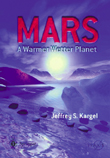 Mars:
A Warmer Wetter Planet
Mars:
A Warmer Wetter Planet
by Jeffrey S. Kargel.
Springer/Praxis Publishing, 2004.
ISBN: 1 8523 3568 8.
Hardcover, $34.95.
Mars, the dry, cold, dusty red planet, was once a very different place. Looking
at evidence from the various martian missions and rovers, this book describes
the newly discovered evidence that suggests a warmer, wetter Mars in the geologic
past and causes us to rethink the mechanisms of planetary change.
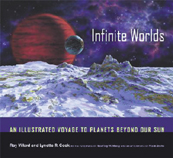 Infinite
Worlds: An Illustrated Voyage to Planets Beyond Our Sun
Infinite
Worlds: An Illustrated Voyage to Planets Beyond Our Sun
by Ray Villard and Lynette R. Cook.
University of California Press, 2005.
ISBN: 0 5202 3710 2.
Hardcover, $39.95.
More than 140 extrasolar planets — worlds beyond our sun and solar system
— have been discovered in recent years with a multitude of scientific and
technological developments in the field of astronomy. Infinite Worlds
describes many of these new scientific findings, complemented by artwork portraying
what these faraway planets might look like.
Back to top
Hubble’s
Anniversary
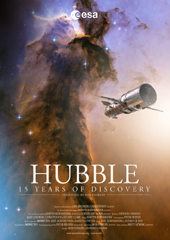 In April,
the Hubble Space Telescope hit its 15th year in orbit around Earth. Launched
in 1990, Hubble has since visualized the universe for us, yielding more than
700,000 pictures of everything from planets within our solar system to dying
stars and far-off galaxies.
In April,
the Hubble Space Telescope hit its 15th year in orbit around Earth. Launched
in 1990, Hubble has since visualized the universe for us, yielding more than
700,000 pictures of everything from planets within our solar system to dying
stars and far-off galaxies.
In commemoration of Hubble’s anniversary, the European Space Agency, which
collaborated with NASA on the telescope, has released a new DVD, Hubble —
15 Years of Discovery, which covers the history of the telescope and its
discoveries. The 83-minute film has narration in three languages: English, German
and Greek, in addition to subtitles in 15 other languages. The film includes
stunning visuals from the telescope, 3-D animations and commentary from scientists
who have used the telescope for their research.
The movie is part of a suite of activities ESA sponsored for the anniversary,
including Hubble Day and planetarium events throughout Europe. The agency has
also made available a CD of the film’s soundtrack, a full-color book and
a variety of educational materials.
Links to the Hubble anniversary products:
Back to top
Untitled Document

 One
geologist who has brought his own photos to laypeople is Ken Hamblin, a professor
emeritus at Brigham Young University (BYU) in Provo, Utah. He was inspired to
put together his book, Beyond the Visible Landscape: Aerial Panoramas of
Utah’s Geology, after looking at the shelves of aerial shots of national
parks such as the Grand Canyon, Zion and Bryce. Hamblin says that often “what
you see is discouraging for the geologist, in a way. Aesthetically, it’s
beautiful,” he says of the books, but “scientifically it’s useless”
because professional photographers tend not to frame images for the geology.
One
geologist who has brought his own photos to laypeople is Ken Hamblin, a professor
emeritus at Brigham Young University (BYU) in Provo, Utah. He was inspired to
put together his book, Beyond the Visible Landscape: Aerial Panoramas of
Utah’s Geology, after looking at the shelves of aerial shots of national
parks such as the Grand Canyon, Zion and Bryce. Hamblin says that often “what
you see is discouraging for the geologist, in a way. Aesthetically, it’s
beautiful,” he says of the books, but “scientifically it’s useless”
because professional photographers tend not to frame images for the geology.
 Creationism’s
Trojan Horse:
Creationism’s
Trojan Horse:  Mars:
A Warmer Wetter Planet
Mars:
A Warmer Wetter Planet Infinite
Worlds: An Illustrated Voyage to Planets Beyond Our Sun
Infinite
Worlds: An Illustrated Voyage to Planets Beyond Our Sun In April,
the Hubble Space Telescope hit its 15th year in orbit around Earth. Launched
in 1990, Hubble has since visualized the universe for us, yielding more than
700,000 pictures of everything from planets within our solar system to dying
stars and far-off galaxies.
In April,
the Hubble Space Telescope hit its 15th year in orbit around Earth. Launched
in 1990, Hubble has since visualized the universe for us, yielding more than
700,000 pictures of everything from planets within our solar system to dying
stars and far-off galaxies.